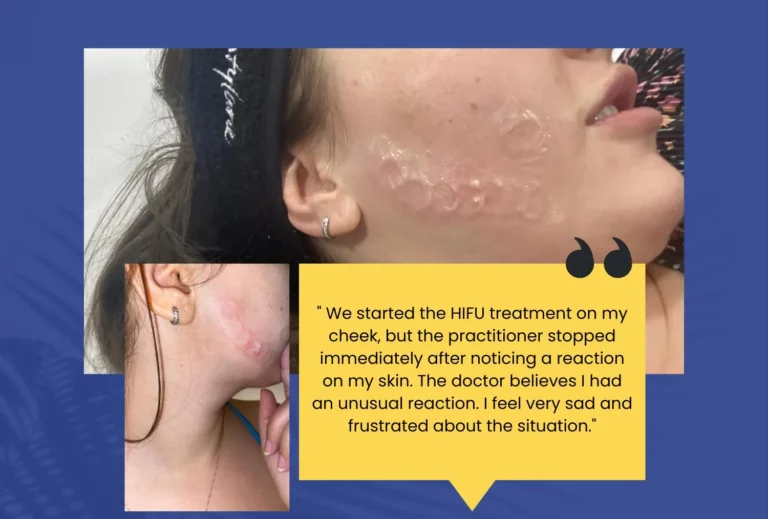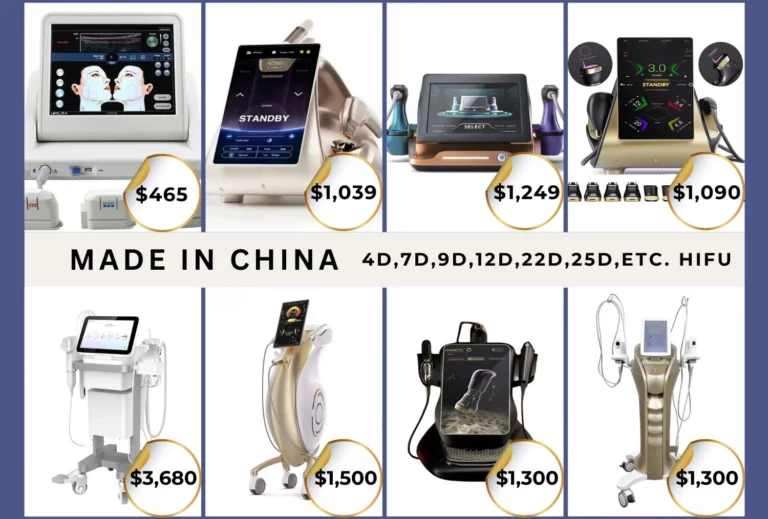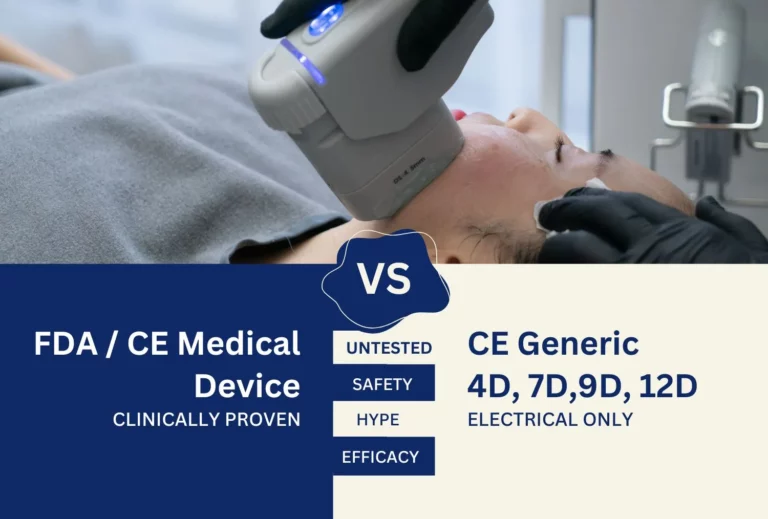1. What is HIFU and why are there limitations?
HIFU (High-Intensity Focused Ultrasound) is a non-invasive technology that uses focused ultrasound waves to stimulate collagen synthesis and achieve a lifting effect. HIFU generates strong thermal energy, which requires strict adherence to restrictions when treating certain areas.
Adverse events following aesthetic HIFU procedures have been described both in the scientific literature and in the FDA’s official incident database (MAUDE). The official documentation of approved devices emphasizes the need for precise targeting and use of the technique.
2. Prohibited/risk areas where HIFU is contraindicated and requires extreme caution
2.1. Area around the eyes (eyelids/periorbital area)
Anatomy (why it's risky):
The skin of the eyelids is the thinnest in the human body; the epidermis here is about ~0.05 mm and underneath it are sensitive structures of the orbit and eyeball. This makes heat and energy transfer particularly critical in this area.
Due to the extremely thin skin and proximity to the eyeball, the periorbital area should not be treated with HIFU without a clear indication and proven real-time visualization. Cases of serious ocular complications have been described in the literature when treating the eyelids. Therefore, clinical protocols and IFU indicate that energy should not be applied directly to the eyelids and that the manipulation should only be performed by trained medical professionals with precisely defined depths and settings.
Documented risks:
Serious eye complications after HIFU around the eyelids:
- BMC Ophthalmology (2024): Traumatic cataract, iridocyclitis and conjunctival hemorrhage have been found in improper HIFU on eyelids BioMed Central.
- Another clinical case: Stromal corneal infiltrates, uveitis, iris atrophy, and cataracts have been reported after a single HIFU procedure on the upper eyelid BioMed Central.
Limitations and recommendations:
- Review of the risks of HIFU (MDPI, 2025): HIFU is prohibited or requires increased caution in areas such as the temporal area and orbital cavities. Misuse can lead to neuromuscular paresis (usually reversible) mdpi.com.
2.2. Neck area (thyroid gland, great vessels and carotid sinus)
Anatomy and why the area is risky
In the anterior neck are located the thyroid gland, thyroid cartilage, and trachea, as well as the carotid arteries with the carotid sinusThese are critical structures; damage or reflex stimulation can lead to vascular accidents.
Official recommendations (IFU)
The instructions for use of approved aesthetic systems, such as Ulthera/Ultherapy, explicitly state to: avoid areas such as "thyroid gland, thyroid cartilage and trachea" and "great vessels and nerves".
Manufacturer's IFU, Rev D – instructions for trained healthcare professionals, 05-2023. Ultherapy
Documented risks
- Vascular trauma (carotid dissection): A clinical case is described in which 7D HIFU for treatment of the cervical region was associated with internal carotid artery dissection and ischemic symptoms; the authors suggest a thermal or off-target mechanism. This is an important signal for caution when applying energy to the area. PMCFrontiers
- Carotid sinus (physiological risk): The carotid sinus contains baroreceptors; mechanical or strong stimulation can cause bradycardia, hypotension, and syncope (carotid sinus hypersensitivity). Although there are no well-documented cases of classic carotid sinus syndrome after aesthetic HIFU, the recommendation is to avoid the area. ncbi.nlm.nih.gov
Official adverse event reports
For official announcements and reports of incidents involving medical devices (including devices for aesthetic procedures), use FDA MAUDE / FDA search engineThis is where MDRs are registered (adverse event reports).
2.3. Ear and temple area (branches of the facial nerve and superficial vessels)
Anatomy and why the area is risky
The branches of the facial nerve (nervus facialis), including the temporal and zygomatic, pass close to the skin. This makes the area sensitive for cosmetic procedures. Incorrectly applied HIFU energy can lead to temporary neuromuscular dysfunction, including paresis of the muscles of facial expression. PubMed
Official recommendations (IFU)
Instructions for use of aesthetic HIFU systems such as Ultherapy emphasize that the applicator must be held steady with accurate visualization and no energy is applied directly to critical anatomical structures, including areas with facial innervation.
Documented risks
- Facial nerve injury (case report): A case of a 33-year-old woman is described in which temporary facial paresis and asymmetry (neuropraxia) occurred after restrictive application of HIFU for skin tightening. PubMedmedicalxpress.com
- Overview of complications: Scientific articles summarize that complications such as nerve irritation are possible with aesthetic HIFU procedures, which is attributed to incorrect settings or lack of visualization.
Official reports
If additional information about possible complications is sought, the FDA MAUDE database contains reports of adverse events associated with HIFU devices, including those for aesthetic procedures. mdpi.com
Key risks in this area
- Temporary facial paresis or asymmetry
- Facial nerve irritation or damage
2.4. Midline of the face (nose, hump)
Anatomy and why the area is risky
The midline of the face, including the nasal hump (dorsum nasi), has thin skin. Applying concentrated ultrasound energy to the nose means that some of the energy can be absorbed by the bone or cartilage skeleton. This increases the sensation of pain and the risk of uneven thermal effects on the skin and subcutaneous structures. It is especially relevant in areas with a small thickness of the soft tissue layer.
Official recommendations (IFU / White papers)
The manufacturers' instructions for use and technical documentation explicitly emphasize the need to confirm appropriate treatment depth and avoid direct focus on bone ("confirm appropriate depth of treatment such as to avoid bone"). The instructions for the technology state that in areas with a thin layer of soft tissue it is especially important to select the correct tip and procedure parameters. Ultherapycasas.md
Documented risks (aesthetic application)
- Uneven result (cosmetic irregularity): In areas with thin soft tissue and non-uniform energy absorption (partially to bone/cartilage), local tightening or uneven skin lifting may occur. This is indicated in the clinical documents and practice notes for the use of shallower or less dense lines in such anatomical areas. Dermatology and Laser Centercasas.md
- Pain, a stronger sensation (bone absorption / periosteal pain): Concentrated energy focused near bony surfaces can cause more pain due to heating of the cartilage surface and reflection of the energy. IFU recommends visualization and depth adjustment to reduce this effect. Ultherapy+1
- Cutaneous thermal complications: Cases of thermal injury and significant local inflammation have been reported with incorrect targeting/application of HIFU to anatomically sensitive areas (common to HIFU applications in cosmetics). This highlights the need for proper technique and use only by trained professionals.
Physiological logic/mechanism
HIFU works by focusing acoustic energy at a specific depth, which induces local thermal coagulation damage. When the soft tissue layer is thin, some of the energy may “impact” or scatter off bone/cartilage. This increased absorption and reflection leads to greater pain sensation, more concentrated local heating, and the risk of uneven tissue contraction or local damage. Therefore, the correct determination of the depth and density of the lines is critically important.
2.5. Bony prominences (cheekbones, jaw)
A similar risk mechanism is observed in the cheekbones and corners of the jaw. As with the nose area, the soft tissues here are relatively thin and the proximity to the bone makes the procedure more sensitive.
Why is the area risky?
In the cheekbones and corners of the jaw, the layer of soft tissue above the bone is limited. When ultrasound energy gets too close to the bone, it can be absorbed or reflected, resulting in severe discomfort and potential thermal stress on the bone.
Important clarification
Compared to the nose or the corners of the jaw, the cheekbone area has slightly more soft tissue (fat and muscle), which reduces direct contact with the bone. However, on the most prominent part of the cheekbone, the layer is relatively thin and it is there that patients often report a characteristic “bone pain” during the HIFU procedure. Therefore, although less common, the mechanism of risk is similar – some of the energy reaches the bone.
Risks
Intense pain (periosteal pain): Literature and technical manuals describe that treatment over bone is often associated with more pain due to higher ultrasound absorption and reflection from bone. This is the main and most proven risk that justifies the recommendation to avoid bony prominences.
Periosteal injury (theoretical risk; rarely described in aesthetic procedures): In therapeutic HIFU applications on bone (e.g. treatment of pain in metastases/osteoid-osteoma), it has been described that HIFU can induce changes in bone and periosteum; this indicates that local trauma may occur under inappropriate parameters. However, in aesthetic procedures, there is a lack of solid series with evidence of frequent cases of true “periosteal injury”, so we must state the risk as possible but rare. PMC+1
Recommendations
Clinical guidelines emphasize the need for careful selection of depth and parameters, particularly in bony prominences, to reduce the risk of pain and adverse effects. These areas should be treated with caution or skipped if a safe depth cannot be guaranteed.
2.6. Pigmented lesions (birthmarks, melanomas)
Why is the area risky??
Pigmented lesions such as birthmarks and melanomas contain active melanin cells (including tumor cells), and thermal stimulation from HIFU can potentially stimulates their activity or growthThis can lead to changes in their behavior, including malignancy, and because of this, many guidelines recommend avoiding treatment on pigmented areas.
Recommendation from regulators (FDA)
FDA document for aesthetic HIFU devices (Focused Ultrasound Stimulator System for Aesthetic Use, 2018) concerns contraindications and warns against avoid lesions in the areas being treatedThis includes active pigmented lesions such as moles or suspicious tumors – an important caveat in the context of aesthetic application. US Food and Drug Administration
3. Safety factors
3.1. Qualification of the therapist
The safety and effectiveness of HIFU procedures depend directly on the level of training of the therapist. Professional training is required, conducted by the manufacturer of the device or by an accredited program. The FDA approval documents (510(k) summaries for the Ulthera System) clearly state that the procedures should only be performed by trained professionals familiar with the specific risks and operating parameters.
3.2. Equipment quality
The use of clinically validated devices is a critical factor for safety. Devices with FDA or CE approval, such as Ultherapy and Ultraformer III, are among the best studied and widely cited in the scientific literature.
The system Double also has published clinical data, but is less frequently mentioned in contemporary review articles. Therefore, device selection should be based on available clinical evidence and official approvals.
3.3. Preliminary assessment of the patient
Before performing the procedure, a detailed patient assessment is recommended, including analysis of skin condition, soft tissue thickness, and marking of risk areas. This allows for individualization of parameters and minimizing possible complications. Such steps are described in the clinical protocols.
4. Alternatives for risk areas
For the eye area:
- Radiofrequency therapy (RF): offers controlled heating of tissues with the ability to work in superficial layers without affecting deep structures.
- Microcurrent therapy: uses low electrical pulses to stimulate muscles and lymphatic drainage, with minimal risk of thermal damage.
Advantage: In both methods, depth and energy are more precisely controlled, making them safer for delicate areas such as the eyelids.
For pigmented lesions:
- Laser therapy: It is applied selectively to pigment cells (melanocytes) without affecting the surrounding tissue.
- Cryotherapy: uses local freezing to remove benign skin lesions; the method is well-established and low-risk with proper patient selection.
Overall conclusion:
Due to the increased risk of complications with the aesthetic application of HIFU in these areas, it is recommended using safe alternative methods, such as those listed above, instead of treating the area with HIFU.
5. Conclusion and recommendations
HIFU is an effective technology for tightening and rejuvenation. Safety it depends on the right choice of zone, device and therapistSome parts of the face and neck are at risk because of their proximity to bones, vessels, and sensitive structures.
It is important:
- the procedure should be performed by a trained specialist;
- to use certified device with visualization;
- Risk areas should be avoided or replaced with alternatives.
Advice to customers:
- Always require qualification documents
- Check the appliances and the certificates
- Discuss risk areas and alternatives
- Don't hesitate to ask questions.



